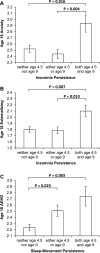Associations of child insomnia, sleep movement, and their persistence with mental health symptoms in childhood and adolescence
- PMID: 24790268
- PMCID: PMC3985117
- DOI: 10.5665/sleep.3656
Associations of child insomnia, sleep movement, and their persistence with mental health symptoms in childhood and adolescence
Abstract
Study objectives: To examine the patterns of insomnia and sleep-related movement from ages 4.5 to 9 years, their concurrent associations with mental health symptoms in childhood, and the longitudinal associations of sleep-problem persistence with mental health symptoms at ages 9 and 18 years.
Design: A 14-year prospective follow-up study. Assessments included maternal report on the Children's Sleep Habits Questionnaire at ages 4.5 and 9, and child mental health symptoms via maternal report at age 4.5, multi-informant (child, teacher, mother) report at age 9, and adolescent report at age 18.
Setting: Community.
Participants: A total of 396 children (51% female).
Interventions: N/A.
Measurements and results: Sleep problems were more common at age 4.5 than 9; symptoms of insomnia and abnormal sleep movement both had persistence rates of 9-10%. At age 4.5, insomnia was associated with hostile-aggressive and hyperactive-distractible behavior, but there were no significant associations for sleep movement. At age 9, both insomnia and sleep movement were associated with symptoms of depression, externalizing, and attention deficit hyperactivity disorder (ADHD). Insomnia persistence was associated with symptoms of depression, externalizing, and ADHD at age 9 and anxiety and externalizing at age 18; sleep- movement persistence was associated with externalizing and ADHD at age 9, and ADHD at age 18. The age 18 persistence effects for insomnia and anxiety and for sleep movement and ADHD were significant when controlling for earlier mental health.
Conclusions: Childhood insomnia and sleep movement are common and associated with mental health symptoms. Their persistence from middle to late childhood predicts associations with specific types of mental health symptoms at age 18.
Keywords: adolescence; anxiety; attention deficit hyperactivity disorder; childhood; depression; externalizing; insomnia; longitudinal; sleep-related movement.
Figures

References
-
- Carvalho Bos S, Gomes A, Clemente V, et al. Sleep and behavioral/ emotional problems in children: a population-based study. Sleep Med. 2009;10:66–74. - PubMed
-
- Chervin RD, Archbold KH, Dillon JE, et al. Associations between symptoms of inattention, hyperactivity, restless legs, and periodic leg movements. Sleep. 2002;25:213–8. - PubMed
-
- Johnson EO, Chilcoat HD, Breslau N. Trouble sleeping and anxiety/ depression in childhood. Psychiatry Res. 2000;94:93–102. - PubMed
-
- Itani O, Kaneita Y, Ikeda M, et al. Disorders of arousal and sleep-related bruxism among Japanese adolescents: a nationwide representative survey. Sleep Med. 2013;14:532–41. - PubMed
Publication types
MeSH terms
Grants and funding
LinkOut - more resources
Full Text Sources
Other Literature Sources
Medical

